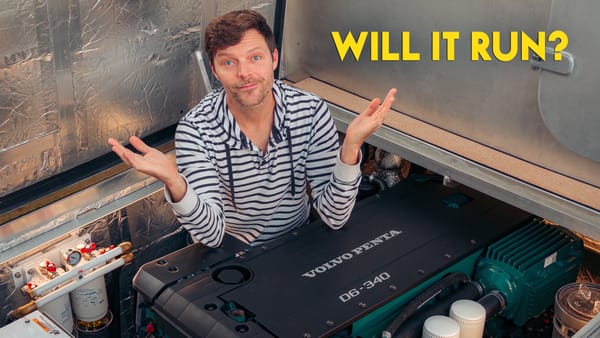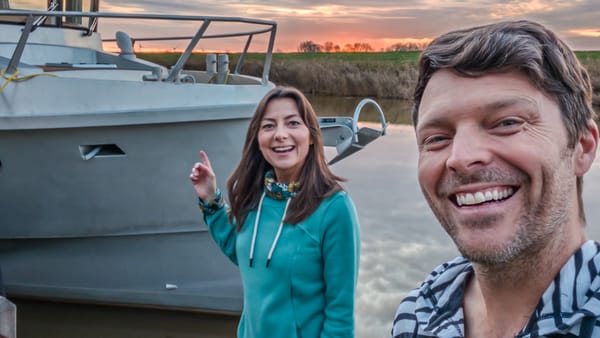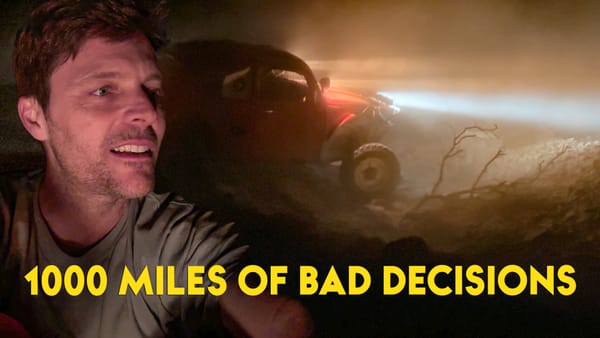No Agent? No Problem! Transit The Panama Canal
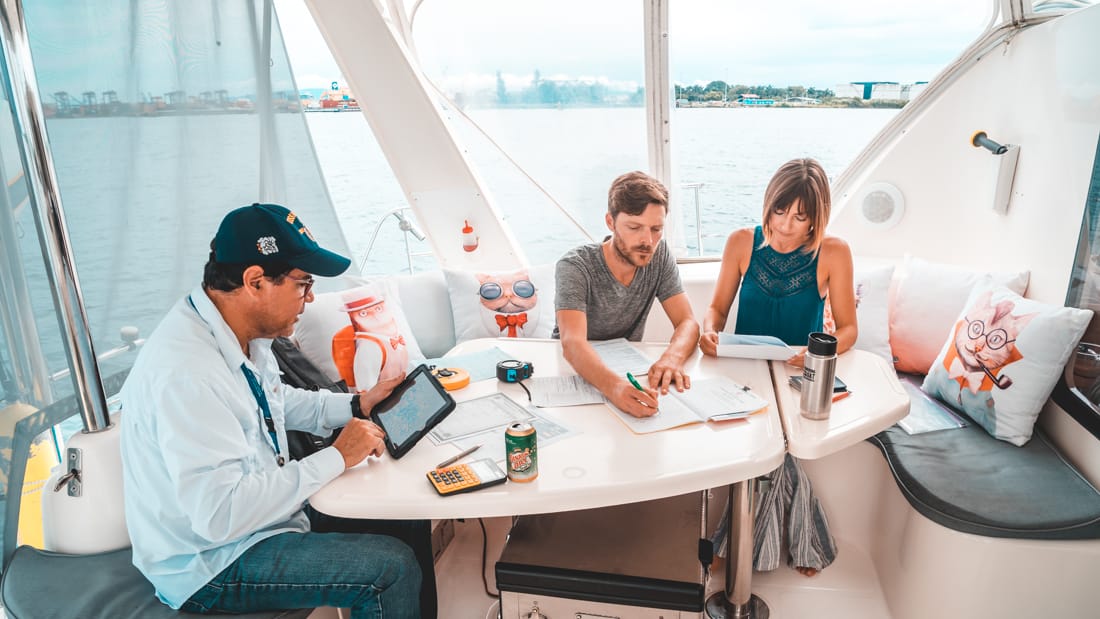
Every sailor wanting to go from the Atlantic Ocean to the Pacific (or vice versa) has two options. Take on Cape Horn or transit the Panama Canal (well, technically you can ship your boat but that’s not sailing).
Now, before we go diving into these two options its important to remind ourselves where we are as sailors.
We’ve been sailing for less than two years and only since arriving in Panama have we earned our first swallow. (Sailors earn a swallow tattoo for every 5,000 nautical miles traveled. The circumference of the earth is 21,639 nautical miles. That’s about 4 swallow.)
Ok, back to those two options…
Option One – Cape Horn
Rounding Cape Horn is to sailing what Mount Everest is to hiking. It’s not for newbies. The westerly winds are aptly named the “furious fifties”. It’s known for being a sailor’s graveyard because of the strong winds, currents, big waves and icebergs. We’re not ready to dodge icebergs yet.
Option Two – Panama Canal
The Canal was built across Panama to save ships from having to go all the way around Cape Horn. But, it’s more than a nautical shortcut from one ocean to another. It’s a historic man made engineering marvel. Ships travel up 85 feet above sea level through a series of massive, seven foot thick lock doors. Over 15,000 ships make the crossing between the Atlantic and Pacific Oceans each year. But, only a small percentage of those are small, non-commercial vessels like ours. While transiting the canal is no Cape Horn, it’s still a big deal.
Making the decision to transit the canal was the easy part. Actually transiting the canal requires planning, preparation, extra crew and a fair amount of cash. The expenses to transit the canal add up quick, which is exactly why we wanted to forgo using an agent. Turns out having no agent is no problem. Money saved, experience gained and knowledge shared!
With our line handlers on board, we’re in full geeky excitement mode. Transiting the Panama Canal is a major milestone for any cruiser. But, we’re about to change oceans among massive cargo ships, good friends and family. It doesn’t get any sweeter than this!
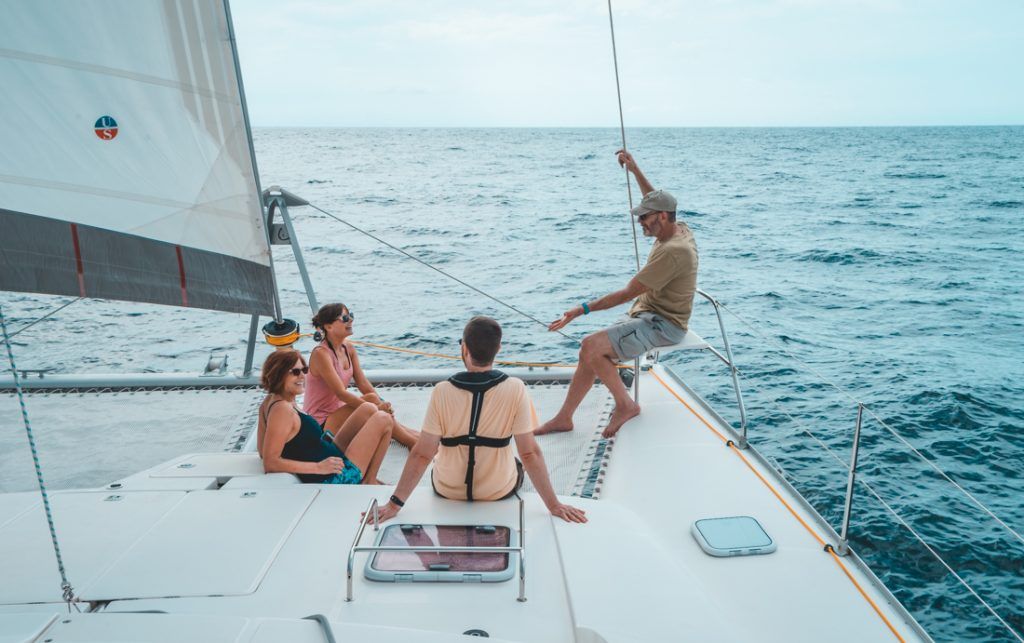
About Our Linehandlers – Meet The Crew
A big thanks to Jason’s Mom (Mary), Peter and John (AKA The RV Geeks) for making the trek out to join us. If you are an RV’er or even a DIY’er you probably already know about The RV Geeks. If not, you’ll want to check out their website and YouTube channel: The RV Geeks. As for Jason’s Mom, she owns a mineral makeup company based out of Dallas called Mineralogie. Having friends & family that can set their own schedules is a major bonus for last minute requests such as “Hey, we’re going through the canal in 10 days…wanna come?”
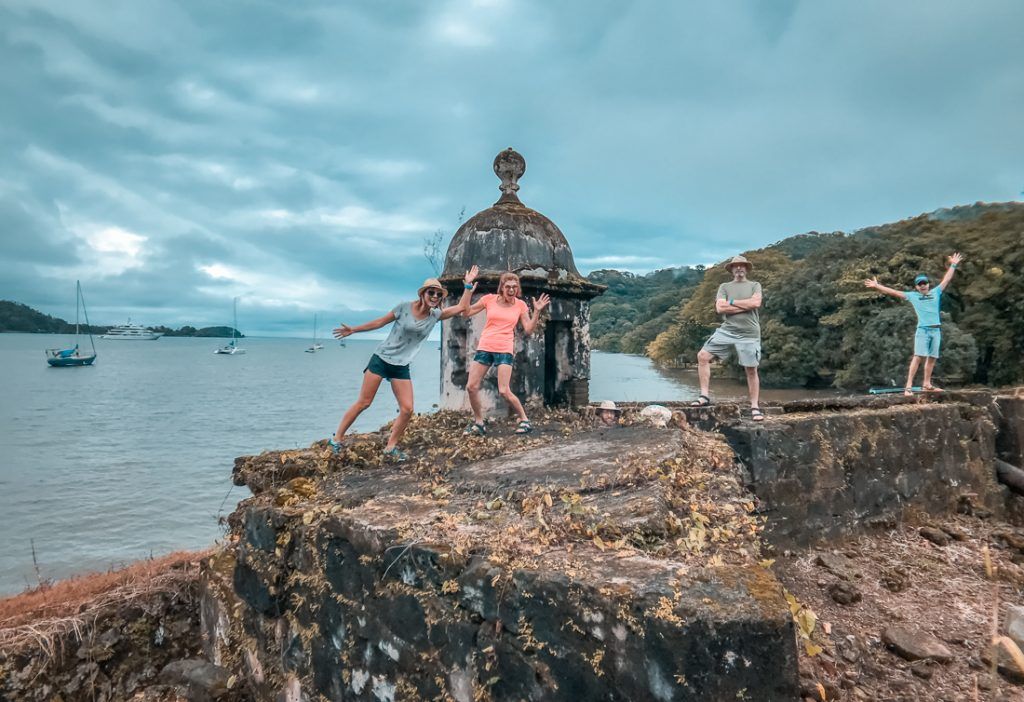
Help Please and Thank You
Before I dive into all the gritty details, I need to ask for your help. We spend an insane amount of time, filming, documenting and creating what you see. Maybe this post will save you $$$ if it gives you the confidence to transit the canal without an agent. If you like our videos and articles, you can help keep the creativity flowing. We’ve listed out all the little (like sharing) and big (join the crew) ways you can help here: gonewiththewynns.com/tip-jar
Best part is, most won’t take more than a few seconds of time or cost you a penny. Thank you for being a part of the journey!
Transiting The Panama Canal, No Agent Needed
Tis The Season
The peak season for yachts transiting the canal is January to March. Around three to nine small boats a day go through. Our admeasurer’s advice: Avoid peak season if you can for more undivided attention and less stress. We decided to transit in November. We literally could have sailed in, got measured and transited the next day.
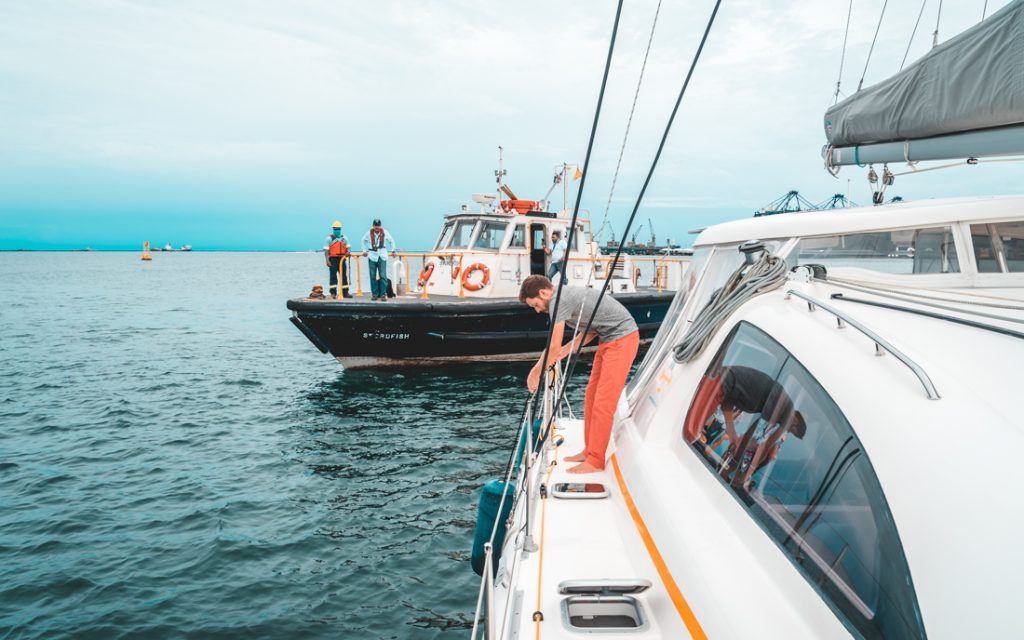
Anchoring vs Marina During Prep For The Transit
The most popular spot seems to be Shelter Bay Marina. Focusing on the transit yacht business, they are the only marina in the area and know the biz, so prices are not cheap. And, everything is a 30-45 minute taxi or bus ride away (at least until the bridge is complete). That said, we’ve heard great things about the owners and no negative feedback.
We prefer being at anchor and the canal has the designated “flats” anchorage that is free. We stayed there for measuring and the night before our transit. We felt totally safe and there was very little traffic at night. Other than the occasional pilot boat wake it’s a calm anchorage. After our canal measurements and prep was complete we sailed back to Linton Bay Anchorage.
If you have boat work to be done before the transit, Linton Bay Marina is only a day sail away, it has a lift and far cheaper slips.
Sailboat Insurance
Boaters insurance is interesting (AKA expensive and complicated). We buy coverage for the areas we plan to travel and read the fine print carefully. As we enter a new country or body of water, we must buy coverage for that area. Insurance prices vary like crazy from boat to boat, sailor to sailor, and of course providers. But, for what it’s worth, we paid an extra $316 to cover us through the canal and add coastal pacific cruising. We will have to re-up again when make the Pacific crossing to French Polynesia.
Want more info on sailboat insurance? Check out this video and post: gonewiththewynns.com/exhausting-journey-buying-cruising-sailboat
Why you might like to have an Agent
Maybe the extra $300-$600 for an agent to manage your transit is in your budget. Maybe you’re in a rush and feel you need the help. Plenty of people we talked to like their agent and enjoyed having them. But in the end, they didn’t do any less prep than we did.
Why You Don’t Need An Agent
The employees of the Panama Canal Authority all speak excellent English. They are professional, organized, helpful and kind.
Everything you need to know is outlined clearly in the transit documentation. Not sure about something? Call the phone numbers listed to ask questions. We were blown away by how quickly they answered the phone and how politely they answered all questions. It was all extremely efficient.
Here is the exact document “form 4352-1” with all the instructions and requirements that our admeasurer handed us: http://www.pancanal.com/common/maritime/forms/4352-ENG-201211.pdf
We read a ton of blog posts and cruising guides before making the decision on Panama Canal agents. We also spoke to fellow cruisers who’d completed the transit with and without an agent. It’s overwhelming how much fear mongering there is about the canal transit. In the end you must go with your gut on what’s best for you. From our experience, we can without a doubt say: Transiting the Panama Canal without and agent was easy and 100% “doable”.
What An Agent Does (That You Can Easily Do because it’s lined out in the document above)
- Handles registering with the canal.
- It’s this short, easy to fill out document “form 4405-1“: http://www.pancanal.com/common/maritime/forms/4405.pdf
- Once filled out the document gets sent to this email address: optc-ara@pancanal.com (for the Atlantic side) or optc-arp@pancanal.com (for the Pacific side).
- Makes the appointment to have your boat measured.
- A quick phone call to: Balboa Admeasurement Office at (507) 272‐4571, or the Cristobal Admeasurement Office at (507) 443‐2293.
- Helps make your payment at the bank (helps arrange a taxi or possibly takes the money to the bank for you, some agents do, some don’t)
- It’s a quick trip to the only Citibank in either town and its listed in the document 4352-1 linked above (although on the Panama City side it says “Niko’s Plaza” but what they mean is next to Niko’s cafe. Ask a cab, or a bus, to take you to Niko’s Cafe Balboa, the Citibank is next door. The phone number for Citi-Balboa listed in the document was incorrect and Google Maps shows multiple listings for Citibank and they’re all the incorrect location…we visited 2 of the wrong listings before finding the actual Citibank in Panama City). There are several ATMs inside Niko’s to get cash (max withdraw was $500).
- Calls the scheduler for a transit date and time.
- An easy phone call made after 6pm on the day you pay the bank: (507) 272‐4202
- Agents can rent you the lines and tires that are required for your transit (for an additional fee).
- Rent 4 lines (125ft) and fenders (AKA – tires wrapped in plastic), to be delivered from Tito +507-6463-5009 (on the Atlantic side) or Roger +507- 6717-6745 (on the Pacific side). If you have lots of fenders you don’t need to rent tires. We only have six fenders and didn’t want to risk any damage to the boat, so we rented 8 tires from Tito. We were told it should be $119 for drop off and collection. Which wasn’t the case, we were expected to pay the guys who dropped them off and picked them up. It was an additional $20 each side. Also the La Playita marina tried to charge us a dinghy dock fee to drop off the lines. We said hell no, called Tito and told him to deal with them. Apparently we could have used our dinghy to meet Tito’s guys and saved the extra fees. So when Tito tells you your fees include pick up and drop off he means on land, he does NOT pay for the boat to bring lines to you at anchor.
- Agents can recommend paid line handlers – There must be a minimum of 4 crew plus the captain no matter how small your boat is. Line handlers are $100 per person per day. They will stay on-board with you overnight if you are transiting from the Atlantic side (2 day transit). You will need to provide one night’s board and two days food and beverages for each person.
- We had family and friends join us but…here is a site for Volunteer Line Handlers (some are fellow sailors wanting to learn the ropes before they transit. It’s also a good site if you want to volunteer): www.panlinehandler.com Many sailors told us having friends or family members on board made the transit much more enjoyable…because there’s a lot of downtime during the canal transit. They were correct!
Extra Tips and Info
Questions we were asked by the Admeasurer
- How fast is your vessel? (Anything over 5 knots will do).
- Do you have a holding tank?
- Do you have shade for the adviser (a bimini of some sort)?
- Do you have a horn?
- What type of engine?
- Which way do your props rotate?
- How much fuel do you carry?
- What’s your Gallons Per Hour (i.e. can you make it through the canal without re-fueling)?
- Do you have AIS (not a requirement in 2017)?
- Do you have working navigation lights?
- Working VHF?
- Do you have the required fenders & lines? (we told him Tito was bringing the day of the transit, he didn’t need to see them)
- Do you have 5 crew lined up to be on board (we told him they were flying in before the transit and didn’t request names or their information).
Our Ad Measurer Informed Us
- We need to provide bottled water and food for our adviser on the day of transit. He does not stay overnight. He will be collected by a pilot boat from Gatun Lake, where we anchor overnight, and join us there again the next morning to complete the trip.
- We asked about food for the adviser because we’ve read horror stories. His answer was basic food served in a clean environment, they’re not necessarily too picky about the food, more of the quality and cleanliness of the meal.
- He warned us that our line handlers must be strong and familiar with tying bowline knots under pressure.
- We asked about stopping at the Smithsonian island on Gatun Lake. He said it’s possible but it must be requested in advance and the Panama Canal Authority will charge an additional fee because we’d be “getting out of line”.
- We asked if not having an agent made more work for him. He said “no”.
- We asked about beer/alcoholic beverages in case the adviser asked for one. He said any canal authority worker on duty should not be drinking.
- We forgot to ask about getting permission to fly a drone while inside the locks and this is something that has to be requested in advance.
Costs To Transit The Panama Canal

Because our Catamaran is 43ft, we fall under the 50ft category. While our total deposit amount paid to the bank was $1875, we did receive our buffer money back for a total of $984 to transit the canal.
Spoiler Alert!
We’re officially on the other side of the Panama Canal and we can honestly say…without a doubt…we made the right decision. The Panama Canal Prep was easy and even fun. We loved going through processes (especially because they run things so smoothly), documenting our experiences and sharing them with all of you. We successfully transited the Panama Canal without an agent. If we did it, you can too!
If you have any thoughts please share in the comments section below. If you have a burning questions please ask! Thanks to each and everyone of you for being a part of the adventure.
Sailing Report
To see our full map with interactive pins, click here: gonewiththewynns.com/map
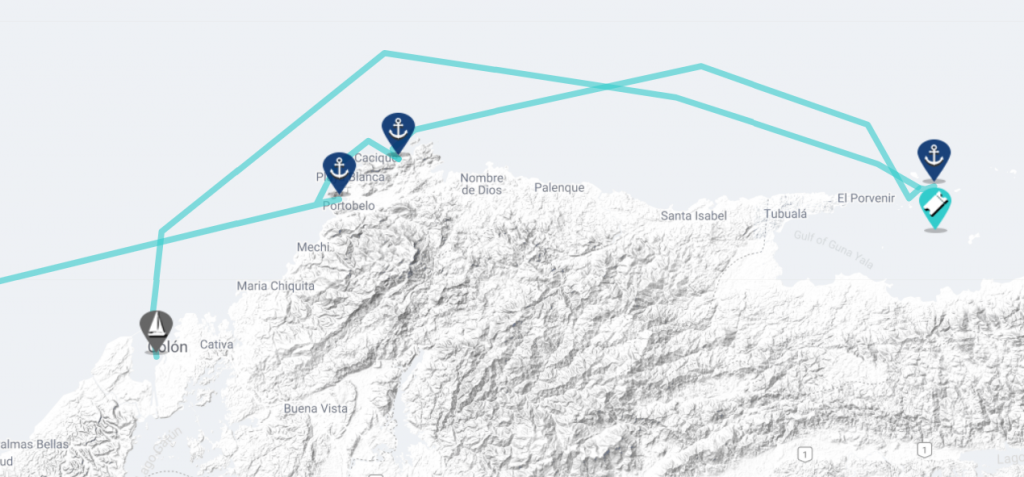
- Dates: 11/14 – 11/27/2017
- Cell & WiFi: We had good cell phone reception here with Clario and MasMovil.
Sailing Specific Gear
- iPad Pro http://amzn.to/2d9Oopf
- iPad Mount at Helm: http://amzn.to/2fT84PG
- Sailing Apps Used:
- iNavx (Chart app we were using to help find the dive site): http://bit.ly/2vGgC51
- Garmin Bluecharts with Active Captain: http://bit.ly/2tgnRmA
- Iridium Go and Predict Wind for weather and communications: bit.ly/PredictWindIridium
- Quatix 5 Watches: https://www.gonewiththewynns.com/product/quatix-5-marine-watch
Cameras Used to Capture This Video
Full Review Of All Our Camera Gear: gonewiththewynns.com/camera-gear-review-2017
- Sony A7ii: com/product/sony-a7ii
- Rode Mic: https://bhpho.to/2hUNFA8
- Sony 24 – 70mm f4 lens: com/product/sony-24-70
- Sony RX (small pocket cam): gonewiththewynns.com/product/productsony-dsc-rx100m-iii-cyber-shot-digital-still-camera
- Gorilla Tripod: http://amzn.to/2A0zwIa
- iPhone 7 Plus: http://amzn.to/2Asmjq7
- Olloclip Lenses: http://amzn.to/2AkjQx9
Drone
- DJI Mavic Pro: http://amzn.to/2vUFXa6
- Drone Filters: http://bit.ly/sandmarc-mavic


